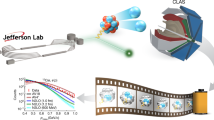Summary
This paper continues the author’s research program on elementary-particle physics from general relativity. The generalized electrodynamic spinor interaction in this theory is studied in detail in regard to the e-p interaction at small mutual separation, the order of nucleon dimensions. The mediating pairs, according to this theory, modify the interaction in a way that leads to its increased strength of coupling, ase 2/[1−(v/c)2]1/2, asv→c, and a reversal from an attractive to a repulsive force, when the electron de Broglie wave-length becomes smaller that its Compton wave-length. The latter corresponds tov exceeding the order of 0.7c. The generalized electrodynamic interaction is found to depend on the factor exp [−b/r−μr]. Theb-term hints at unification of electrodynamics with the weak force and the μ-term hints at unification with the strong (nuclear) force. The detailed interaction is generally velocity dependent and it is expressed in terms of a power series in (b/μ) <r −2>, where <r> is the order of the proton radius,b∼-0.158 fm (from previous studies), and μ plays the role of a «screening» constant in the e-p interaction, depending on the polarizability of the background mediating pairs.
Riassunto
In questo lavoro continua il programma di ricerca dell’autore sulla fisica delle particelle elementari nella relatività generale. Si studia in dettaglio l’interazione elettrodinamica spinoriale generalizzata in questa teoria con riferimento all’interazione e-p a piccola distanza, dell’ordine delle dimensioni dei nucleoni. Le coppie di mediazione, secondo questa teoria, modificano l’interazione in un modo che porta ad un aumento della forza d’accoppiamento di tipoe 2/[1−(v/c)2]1/2 quandov→c, e ad un'inversione della forza da attrattiva a repulsiva, quando la lunghezza d’onda di de Broglie dell’elettrone diventa piú piccola della sua lunghezza d’onda di Compton. Quest’ultima corrisponde a unv di ordine superiore a 0.7c. Si trova che l’interazione elettrodinamica generalizzata dipende dal fattore exp [−b/r−μr]. Il termineb si riferisce all’unificazione della elettrodinamica con la forza debole e il termine μ all’unificazione con la forza forte (nucleare). L’interazione in dettaglio è generalmente dipendente dalla velocità e si esprime in termini di una serie di potenze di (b/m)<r −2>, dove <r> è dell'ordine del raggio del protone,b∼-0.158 fm (da studi precedenti) e μ gioca il ruolo di costante di «schermo» nell’interazione e-p, che dipende dalla polarizzabilità delle coppie di mediazione del fondo.
Резюме
В этой статье автор продолжает развивать программу исследования физики элементарных частиц из общей теории относительности. Подробно исследуется обобщенное электродинамическое спинорное взаимодействие в этой теории применительно к e-p взаимодействию на малых расстояниях, порядка размеров нуклона. Связывающие пары, согласно этой теории, видоизменяют взаимодействие таким образом, что величина связи увеличивается, как\(e^2 /\sqrt {1 - v^2 /c^2 } \), когдаv→c, и сила притяжения изменяется на силу отталкивания, когда дебройлевская длина волны электрона становится меньше комптоновского длины волны. Последнее соответствует случаю, когдаv превышает 0.7c. Получено, что обобщенное электродинамическое взаимодействие зависит от множителя ехр [−b/r−μr]. Членb указывает на объединение электродинамики со слабой силой, а член μ указывает на объединение с сильной (ядерной) силой. Детальное взаимодействие, в общем случае, зависит от скорости и выражется в виде ряда по (b/μ)<r −2>, где <r> имеет порядок радиуса протона,b∼-0.158 fm (из предыдущих исследований) и μ играет роль постоянной «экранирования» в e-p взаимодействии, которое зависит от поляризуемости связывающих пар фона.
Similar content being viewed by others
References
M. Sachs:Int. J. Theor. Phys. 5, 161 (1972);M. Sachs andS. L. Schwebel:Suppl. Nuovo Cimento,21, 197 (1961).
M. Sachs andS. L. Schwebel:Nucl. Phys.,43, 204 (1963);M. Sachs: inNucleon Structure, edited byL. I. Schiff andR. Hofstadter (Stanford, Cal., 1964), p. 366.
M. Sachs:Nuovo Cimento A,53, 561 (1968).
H. Yu andM. Sachs:Int. J. Theor. Phys.,13, 73 (1975).
M. Sachs:Lett. Nuovo Cimento,27, 586 (1980).
M. Sachs:Nuovo Cimento A,66, 94 (1981).
M. Sachs:Nuovo Cimento,31, 98 (1964);Int. J. Theor. Phys.,4, 453 (1971).
C. G. Darwin:Proc. R. Soc. London Ser. A,118, 654 (1928);N. F. Mott andH. S. W. Massey:The Theory of Atomic Collisions, 2nd edition (Oxford, 1949), p. 67.
M. Sachs:Int. J. Theor. Phys.,4, 145 (1971).
P. P. Debye andE. Hückel:Z. Phys.,24, 185 (1923).
G. N. Watson:Theory of Bessel Functions, 2nd edition (Cambridge, 1944), p. 434. A Table ofK nis given on p. 737–739.
G. N. Watson:Theory of Bessel Functions, 2nd edition (Cambridge, 1944), p. 78.
Author information
Authors and Affiliations
Additional information
Traduzione a cura della Redazione.
Первебено ребакцией.
Rights and permissions
About this article
Cite this article
Sachs, M. A generalized e-p interaction at small distances from a new approach to electrodynamics. Nuov Cim A 70, 229–242 (1982). https://doi.org/10.1007/BF02814036
Received:
Published:
Issue Date:
DOI: https://doi.org/10.1007/BF02814036



